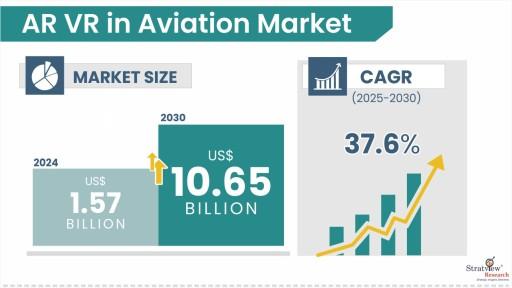The Transformative Role of AR/VR in Aviation Training and Maintenance

Introduction:
The aviation industry is continually seeking ways to improve efficiency, safety, and training processes. Augmented Reality (AR) and Virtual Reality (VR) have emerged as transformative technologies, offering significant advancements in training and maintenance. These innovations are not only enhancing pilot and crew training but are also revolutionizing aircraft maintenance procedures.
The global AR VR in aviation market is expected to grow from USD 1.57 billion in 2024 to USD 10.65 billion by 2030, at a healthy CAGR of 37.6% during 2025-2030.
Key Drivers:
-
Enhanced Training Simulations: AR and VR technologies enable highly realistic flight simulations, offering a safe and cost-effective environment for pilots to train. VR allows trainees to immerse themselves in realistic flight scenarios, enhancing their ability to handle real-world emergencies. The use of AR overlays during training provides real-time, contextual information, enabling better decision-making.
-
Improved Maintenance Procedures: AR is particularly beneficial in aircraft maintenance, allowing technicians to view step-by-step repair instructions, schematics, and diagnostics through AR glasses or heads-up displays. This reduces errors, improves precision, and enhances the overall efficiency of the maintenance process, reducing aircraft downtime.
-
Cost Savings: AR and VR simulations reduce the need for costly physical flight simulators and aircraft downtime for maintenance. Virtual training platforms enable airlines to provide consistent, high-quality training across various locations, while AR-assisted maintenance speeds up turnaround times.
Challenges:
While the potential is immense, the integration of AR and VR into aviation faces several hurdles:
-
High Initial Investment: The cost of developing and implementing AR/VR systems can be significant, particularly for smaller airlines and maintenance providers.
-
Adoption Resistance: The aviation sector is traditionally conservative when it comes to adopting new technologies. Many stakeholders are hesitant to fully embrace AR and VR until their effectiveness has been proven in long-term operational settings.
Opportunities:
The AR/VR market in aviation is expected to experience substantial growth as the technologies mature. The development of more affordable and user-friendly AR/VR systems will drive adoption, particularly in flight training and aircraft maintenance. The rise of electric and autonomous aircraft, which require new types of training and maintenance protocols, further accelerates the demand for AR/VR solutions.
To get free sample, Click Here: https://www.stratviewresearch.com/Request-Sample/4195/ar-vr-in-aviation-market.html#form
Conclusion:
The future of AR and VR in aviation looks promising, with the potential to reduce training costs, enhance maintenance efficiency, and improve safety standards. As these technologies become more accessible and integrated into the industry, the aviation sector will experience profound changes, bringing more efficient and effective processes to the forefront.
- Information Technology
- Office Equipment and Supplies
- Cars and Trucks
- Persons
- Books and Authors
- Tutorials
- Art
- Causes
- Crafts
- Dance
- Drinks
- Film
- Fitness
- Food
- Games
- Gardening
- Health
- Home
- Literature
- Music
- Networking
- Other
- Party
- Religion
- Shopping
- Sports
- Theater
- Wellness



